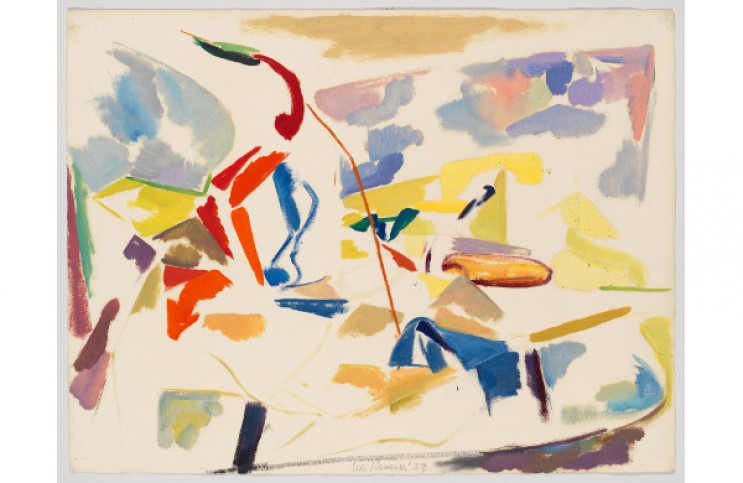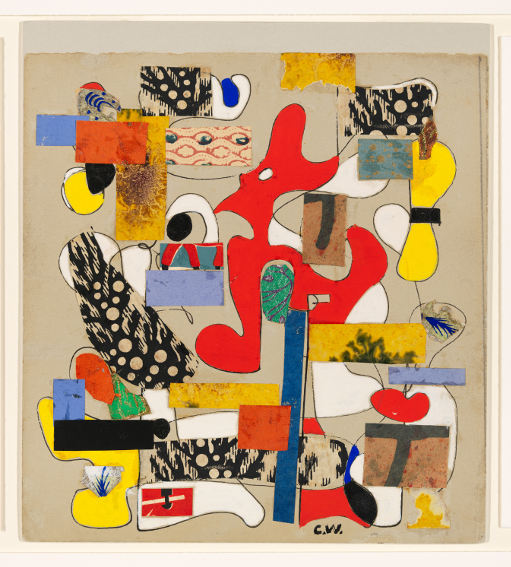
Women in American Abstraction, 1930-1950
American abstract artists faced many hurdles throughout the 1930s and 1940s. Entering a discipline still dominated by realism and ruled by powerful art critics and institutions, abstract artists had to find creative ways to promote their work and gain acceptance in an increasingly tumultuous world. At the forefront were bold, talented female artists who additionally had to navigate complex social and cultural dynamics throughout the pre- and post-war periods. To date, their contributions to early American abstraction have often been overlooked in favor of male pioneers. However, to fully understand the history of art, we must recognize the women who paved the way for abstraction through their creativity, aesthetics, and advocacy.
Early Abstraction
Abstraction is widely recognized to have begun in Europe in the late nineteenth century as some artists moved away from realism and explored shapes, textures, and tones in greater detail. Technological advancements, including increased communication and travel, allowed European and American artists to exchange ideas more than ever before. Likewise, many European artists fleeing the terrors of World War I and World War II brought new techniques and theories to the United States. This led to a burgeoning group of American artists interested in abstraction, many having visited artists in Europe or taken courses from European refugees living in the United States. However, abstraction was particularly reviled by the American art establishment, which barred abstract artists from exhibiting in galleries and museums, blacklisted them in the press, and prevented them from pursuing fruitful careers.
Opportunities for Women
The chaos of the 1930s, surprisingly, blew open the doors for abstract artists in America. In response to high unemployment in the arts community during the Great Depression, the United States government created the Works Progress Administration (WPA) Federal Art Project. Artists from all backgrounds (women and abstract artists included) were offered paid positions on government-sponsored art projects during the Depression and wartime years. Thousands of artists were hired, including future trailblazers like Lee Krasner, Dorr Bothwell, and Louise Nevelson, to beautify institutions around the United States with murals, paintings, and other designs. Other artists, such as Irene Rice Pereira, helped establish federally funded art schools to provide art classes to underprivileged students. Taking advantage of these unique programs, female artists were able to earn an income through art and gain critical experience in teaching, art-making and public engagement. These skills would be instrumental as they created, managed, and promoted the diverse discipline of abstraction and their own careers.
Other women including Alice Trumbull Mason, Esphyr Slobodkina, and Ray Kaiser (later Eames) helped create a new organization, American Abstract Artists (AAA), to promote abstraction to the public and provide exhibition spaces for artists. Established in 1936 in New York City, AAA was formed in response to the Museum of Modern Art’s first exhibition on abstraction held the same year. This exhibition, entitled Cubism and Abstract Art, almost exclusively featured European artists – constituting further institutional rejection of American abstract artists. Slobodkina wrote the AAA’s Historical Outline, still published on their website today, which summarized the desperate need for this group: “What were the circumstances under which this unique organization sprang up and rapidly took root? . . .The year was 1936. The place – New York City. The period – economic depression, and practically total isolation of the general public from all contact with current advanced aesthetic trends.”
Within one year, AAA hosted its first exhibition at the Squibb Galleries in New York. Although the show was well-attended and received generally positive public feedback, the press still reacted with hostility. However, AAA went on to show in many local venues, slowly garnering a growing base of admirers and collectors even as the Great Depression and World War II dampened spirits and lightened pockets. Women were major players in AAA, taking center stage at exhibitions, writing critiques, and holding leadership roles – including founders Mason and Slobodkina, who both served terms as President of AAA.

Charmion von Wiegand (1896-1983), Untitled, c. 1942. Collaged paper, opaque watercolor and pen and ink on paper, 8 1/2 × 8 1/16 in. (21.6 × 20.5 cm). Whitney Museum of American Art, New York; gift of Alice and Leo Yamin 91.84.5. © Estate of Charmion von Wiegand; Courtesy of Michael Rosenfeld Gallery LLC, New York, NY
Critical Reception
However, even as abstraction began to gain footholds in American culture, women still faced significant difficulties. Despite some advances made during the war allowing women to work outside of the home, female artists were scrutinized for doing work that was not strictly domestic or war-related. Many pioneers of this period are remembered more for their famous husbands than for their contributions to abstraction, including Ray Kaiser (later Eames, married to Charles Eames), Lee Krasner (married to Jackson Pollock) and Elaine De Kooning (married to Willem De Kooning). However, their artistic influence on their husbands cannot be denied. Just look at Kaiser, a highly trained artist who collaborated with her architect husband on several projects. Her use of organic forms and tension between spaces is a central feature of their designs and it is what made the Eames name so celebrated. Likewise, Krasner’s efforts to promote Pollock’s legacy after his untimely death in 1956 is largely why his work is so celebrated today.
Many galleries and museums also refused to exhibit female artists: gallerist Samuel Kootz, a big supporter of Abstract Expressionism, supposedly said this was because they were too much trouble. On the flip side, many critics would initially respond favorably to works by female abstract artists – until they discovered the creator was a woman. Krasner recounted that a critic once said of her work: “We learned that the artist was a woman in time to check our enthusiasm.” As a result, several artists altered their names to hide their femininity. Irene Rice Pereira exhibited her dynamic geometric paintings under the name of I. Rice Pereira instead. Likewise, artist Dorr Bothwell legally changed her name from Doris to gain more favorable reception from critics for her surrealist works. That said, many male leaders of the movement still framed these artists’ works in relation to their womanhood. The legendary Hans Hoffman, who trained many female abstract artists, once said that Krasner’s work was “so good that you would not know it was done by a woman.” Despite the obvious quality of their work, women artists were constantly reminded that femininity was a tool used against them to justify the art world’s rejection of their craft.
Freedom in Abstraction
The irony is, of course, that abstraction – with its diversity of expression, lack of concrete forms, and myriad of subjects – is generally not classified as masculine or feminine. In looking at an abstract work of art, a viewer would be hard-pressed to identify the sex of the artist who made it. Take, for instance, Alice Trumbull Mason’s 1945 print Labyrinth of Closed Forms, a conglomeration of rounded and rectangular shapes atop a shaded background. The work plays with grayscale, white space, and interactions between forms – nothing about the work speaks to Mason’s identity as a woman. Elaine De Kooning, likewise, embraced elements of figuration within her colorful, ethereal brushstrokes just as many male Impressionist artists had done with light a few decades before. Through abstraction, women could challenge ideas of ‘feminine’ aesthetics and break out of previous molds. However, finding real acceptance within the artistic community remained elusive – perhaps until now.
What is remarkable about the women abstract artists of the 1930s and 1940s is their resilience and commitment to their craft. Through economic catastrophe and global war, they found ways to remain inspired, engaged, and active within their field. As a result, their work and legacies survive to this day. It is not too late to recognize the achievements of these individuals during this remarkable time in history.
The Whitney Museum of American Art in New York City has curated an exhibition to explore the work and achievements of several female American abstract artists during the pre- and post-war period. “Labyrinth of Forms: Women and Abstraction, 1930-1950” will be on view until March 2022.
By Emelia Lehmann
Featured image: Lee Krasner (1908-1984), Still Life, 1938. Oil on paper, 19 × 24 3/4 in. (48.3 × 62.9 cm). Whitney Museum of American Art, New York; purchase in honor of Charles Simon, with funds given by his friends from Salomon Brothers on the occasion of his 75th birthday, and with funds from an anonymous donor and the Drawing Committee 90.19. © 2021 The Pollock-Krasner Foundation/Artists Rights Society (ARS), New York






